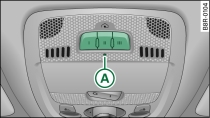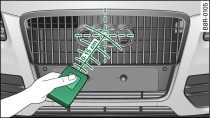Applies to vehicles: with HomeLink
Programming of HomeLink is done at the operating unit in the headliner and at the radiator grille.
At the operating unit
Switch on the ignition (do not start the engine).
Press and hold down the two outer HomeLink buttons Fig. 1 until the indicator diode -A- Fig. 1 begins to flash after about 20 seconds. This procedure will delete the standard factory settings and does not need to be repeated when programming the other buttons.
Press the particular HomeLink button which you would like to program.
Wait until the diode -A- begins to flash. The HomeLink module now remains in training mode for 5 minutes.
Now step in front of your vehicle with the original hand-held transmitter for the garage door opener or any other device you wish to assign to the HomeLink control button.
At the radiator grille
Hold the original hand-held transmitter at or near the centre of your car's radiator grille Fig. 2.
Press the activator button on the original hand-held transmitter.
As you do so, watch the turn signals on your vehicle. HomeLink confirms successful programming by flashing all four turn signals three times.
If the turn signals fail to flash three times, repeat the procedure with the transmitter held at a different distance from the radiator grille.
The proper distance between the hand-held transmitter and the HomeLink module at the radiator grille depends on the system you want to train. It may require several attempts.
The turn signals will flash once if the time limit for the programming mode has been exceeded. In this case the programming procedure needs to be performed again. Repeat the sequence at the operating unit starting with step 3.
The programming instructions above also apply to the other control buttons. Start with step 3 if you wish to proceed and program the other two buttons.
If the garage door or other devices still fail to be activated with the HomeLink control buttons after programming is completed, it is possible that these systems might be working with a rolling code instead of the normal fixed security code. If this is the case, a rolling code programming is required in addition to the steps described above. Link

